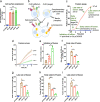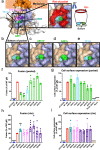A surface pocket in the cytoplasmic domain of the herpes simplex virus fusogen gB controls membrane fusion
- PMID: 35767585
- PMCID: PMC9275723
- DOI: 10.1371/journal.ppat.1010435
A surface pocket in the cytoplasmic domain of the herpes simplex virus fusogen gB controls membrane fusion
Abstract
Membrane fusion during the entry of herpesviruses is carried out by the viral fusogen gB that is activated by its partner protein gH in some manner. The fusogenic activity of gB is controlled by its cytoplasmic (or intraviral) domain (gBCTD) and, according to the current model, the gBCTD is a trimeric, inhibitory clamp that restrains gB in the prefusion conformation. But how the gBCTD clamp is released by gH is unclear. Here, we identified two new regulatory elements within gB and gH from the prototypical herpes simplex virus 1: a surface pocket within the gBCTD and residue V831 within the gH cytoplasmic tail. Mutagenesis and structural modeling suggest that gH V831 interacts with the gB pocket. The gB pocket is located above the interface between adjacent protomers, and we hypothesize that insertion of the gH V831 wedge into the pocket serves to push the protomers apart, which releases the inhibitory clamp. In this manner, gH activates the fusogenic activity of gB. Both gB and gH are conserved across all herpesviruses, and this activation mechanism could be used by other gB homologs. Our proposed mechanism emphasizes a central role for the cytoplasmic regions in regulating the activity of a viral fusogen.
Conflict of interest statement
The authors have declared that no competing interests exist.
Figures






Similar articles
-
Herpes Simplex Virus 1 Entry Glycoproteins Form Complexes before and during Membrane Fusion.mBio. 2022 Oct 26;13(5):e0203922. doi: 10.1128/mbio.02039-22. Epub 2022 Aug 16. mBio. 2022. PMID: 35972147 Free PMC article.
-
The Fusion Loops of the Initial Prefusion Conformation of Herpes Simplex Virus 1 Fusion Protein Point Toward the Membrane.mBio. 2017 Aug 22;8(4):e01268-17. doi: 10.1128/mBio.01268-17. mBio. 2017. PMID: 28830949 Free PMC article.
-
Multiple Sites on Glycoprotein H (gH) Functionally Interact with the gB Fusion Protein to Promote Fusion during Herpes Simplex Virus (HSV) Entry.mBio. 2023 Feb 28;14(1):e0336822. doi: 10.1128/mbio.03368-22. Epub 2023 Jan 11. mBio. 2023. PMID: 36629412 Free PMC article.
-
Two Sides to Every Story: Herpes Simplex Type-1 Viral Glycoproteins gB, gD, gH/gL, gK, and Cellular Receptors Function as Key Players in Membrane Fusion.Viruses. 2021 Sep 16;13(9):1849. doi: 10.3390/v13091849. Viruses. 2021. PMID: 34578430 Free PMC article. Review.
-
Herpesvirus gB: A Finely Tuned Fusion Machine.Viruses. 2015 Dec 11;7(12):6552-69. doi: 10.3390/v7122957. Viruses. 2015. PMID: 26690469 Free PMC article. Review.
Cited by
-
The Autonomous Fusion Activity of Human Cytomegalovirus Glycoprotein B Is Regulated by Its Carboxy-Terminal Domain.Viruses. 2024 Sep 18;16(9):1482. doi: 10.3390/v16091482. Viruses. 2024. PMID: 39339958 Free PMC article.
-
A critical review on antiviral peptides derived from viral glycoproteins and host receptors to decoy herpes simplex virus.Microb Biotechnol. 2023 Nov;16(11):2036-2052. doi: 10.1111/1751-7915.14342. Epub 2023 Sep 23. Microb Biotechnol. 2023. PMID: 37740682 Free PMC article. Review.
-
N-Linked Glycosylation and Expression of Duck Plague Virus pUL10 Promoted by pUL49.5.Microbiol Spectr. 2023 Aug 17;11(4):e0162523. doi: 10.1128/spectrum.01625-23. Epub 2023 Jun 28. Microbiol Spectr. 2023. PMID: 37378543 Free PMC article.
-
Targeted mutagenesis of the herpesvirus fusogen central helix captures transition states.Nat Commun. 2023 Dec 2;14(1):7958. doi: 10.1038/s41467-023-43011-w. Nat Commun. 2023. PMID: 38042814 Free PMC article.
-
Oncolytic α-herpesvirus and myeloid-tropic cytomegalovirus cooperatively enhance systemic antitumor responses.Mol Ther. 2024 Jan 3;32(1):241-256. doi: 10.1016/j.ymthe.2023.11.003. Epub 2023 Nov 4. Mol Ther. 2024. PMID: 37927036 Free PMC article.
References
-
- Cooper RS, Georgieva ER, Borbat PP, Freed JH, Heldwein EE. Structural basis for membrane anchoring and fusion regulation of the herpes simplex virus fusogen gB. Nat Struct Mol Biol. 2018;25(5):416–24. Epub 2018/05/08. doi: 10.1038/s41594-018-0060-6 ; PubMed Central PMCID: PMC5942590. - DOI - PMC - PubMed
Publication types
MeSH terms
Substances
Grants and funding
LinkOut - more resources
Full Text Sources
Medical

